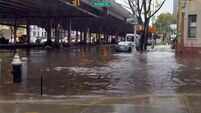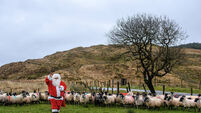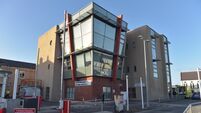Burning issue: Heatwaves and floods are the new normal

The scorching weather has brought a few questions to the forefront of our minds. Chief among them is: What if our weather was like this all the time?
Ireland is, very slowly, emerging from a heatwave the like of which most of us cannot really remember.
After about 10 days of borderline 30C temperatures and the scorching days and uncomfortable nights that go hand in hand with them, this weekend will likely see a more temperate weather-set, before we return to the more familiar Irish summer next week.
The scorching weather, while enjoyable for many, in moderation at any rate, has brought a few questions to the forefront of our minds. Chief among them is: What if our weather was like this all the time?
That’s a state of affairs that is far closer to reality than you might like to think. For those who worry about climate change on an existential level, it’s not a new question either.
Over the past week, Ireland has breached 30C for only the fifth time since the baking-hot summer of 1995.
We’ve also experienced our first tropical night — that is, one where the temperature never falls below 20C — in 20 years. At the same time, it has barely rained for a month.
How did we get here? While the weather seen in the past week has been exceptionally hot, it still hasn’t come close to the highest high in 2018 — 32C at Shannon — nor to Ireland’s record temperature of 33.3C. And that particular measurement came 134 years ago.

“We might not have broken the all-time record, but we’ve come close, and the North had its highest-ever temperature twice in the past week,” says Bonnie Diamond, communications meteorologist with Met Éireann.
“What is extreme is how long these temperatures have been lasting. We’re on the Atlantic so it’s not unusual to see a high-pressure system meaning a warm few days. But our weather is normally very variable. It is unusual that this spell has lasted so long,” she says.
She describes how the heatwave came to be in purely meteorological terms. The Mediterranean jet stream warm air current is currently sitting above Ireland and the UK, quite a deal further north than its usual haunts of the Spain/Portugal region.
That means the areas of colder, low-pressure air which typically roll over Ireland from the Atlantic bringing cooler, wetter weather with them are being held at bay by the warmer high-pressure system.
“That means strong sunshine and day-on-day heat,” Ms Diamond says.
Has climate change caused the weather we’re seeing? That’s a really complicated question.
“It’s normal for the jet stream to fluctuate, it doesn’t have a static position,” she says of the phenomenon that has brought about the heatwave.
That doesn’t mean that she doesn’t believe the fingerprints of climate change aren’t to be found on the current spate of hot weather.
“We’ve come very close to the dry temperature record for Ireland,” Ms Diamond says. “The evidence for climate change is overwhelming around the world, we’ve had the 10 warmest years globally over the past 10 years.”
In terms of the heatwave, there are plenty of positives and a few negatives.
“We welcome this weather because we can’t go on holidays at the moment,” she says.
“Not everyone enjoys the heat though, particularly the very young, the infirm, and the elderly. Sleep is difficult. It has probably been a challenging heatwave for them.”
Pets are also struggling at present, with dog charities, in particular, advising owners to walk their animals either early in the morning or late in the evening to avoid blazing ground temperatures.
“But also, it hasn’t rained for a month. Farmers are crying out for rain for grass and crop growth. It puts the health service under pressure, and we also have issues of very high ultraviolet ray levels.
"Irish people aren’t used to the sunshine, and they may not be taking the precautions of sun cream and not going out during the times of heaviest sun,” Ms Diamond says.
The point about water is instructive. While drought-like conditions of the likes seen in 2018 (when Irish Water introduced a six-week hosepipe ban in the Dublin region) haven’t taken hold, the clamour to conserve water has been growing.
It’s probably, apart from the general discomfort, the biggest issue the heatwave has presented.
The utility said that it is continuing to see high levels of domestic and commercial demand for drinking water as the wave continues, particularly in tourist spots along the coastline as people flock to staycation destinations.
A spokesperson said that 70 of Ireland’s 750 water treatment plants are displaying drought, or risk-of-drought, conditions, with the majority of those in counties Limerick, Kerry, Cork, Wexford, and Donegal, with targeted night-time restrictions in place in those areas in order to restrict impacts to daytime supplies.
There are currently no plans to implement a water conservation order, they said.
“While we saw more rain than usual in May, it followed one of the driest Aprils on record, and in some areas of the country we’ve seen little or no rain since early June,” Tom Cuddy, Irish Water’s head of asset operations, said.
“Conserving water is something that we should be doing year-round, not just when supplies come under pressure due to drought conditions and seasonal increases in demand. Small changes can have lasting results.”
Of course, other developed countries are used to dealing with hot periods like what we are currently experiencing on a far more frequent basis, with little impact on water supply.
Much of the threat to Ireland is unfortunately via the poor quality of its own water infrastructure.
“Our pipework and general infrastructure is chronically poor,” says Cathal Nolan, climate scientist with UCC. “When weather like this happens we almost immediately have water shortages.”

He’s not wrong. Irish Water has been spending €100m a year in order to try and reduce the level of leaks in our systems, with an aim of losing just 38% of drinking water to leaks by end 2021, a level of waste which is hard to comprehend.
“If we continue with weather like this until the end of the century the infrastructure is going to have to drastically improve,” Mr Nolan says.
So are we going to keep getting weather like this, and is that really such a bad thing?
Now we move into the realms of climate science, as opposed to forecasting.
A noteworthy contrast to the heatwave seen in Ireland over the past week has been the devastation wrought by flooding at the same time in Germany.
Storms like those, which caused the deaths of roughly 200 people, could become up to 14 times more frequent by the end of the century in a worst-case scenario, according to climate scientists. The same is true for extreme-heat weather events.
“To give a general backdrop, the mass release of greenhouse gases has been one of the unintended consequences of progress,” says Keith Lambkin, a senior climatologist with Met Éireann.
“The world on average is now about 1.2°C warmer than it was at the time of the industrial revolution. The goal of the Paris Accord (the international agreement signed by 195 countries in December 2015) is to try and keep the global temperature increase to 2 degrees above pre-industrial levels.”
As things stand, hitting that goal looks very tricky indeed. Maybe impossible.
Mr Lambkin describes a bell curve, a way of predicting the probability of events, with extremes of weather in this case to the left and right of the curve for cold and hot respectively.

Put simply, at the moment the curve is moving to the right — suggesting less extremes of cold, but milder, wetter winters — and more extremes of heat as we move into the future.
“So at the moment, spring is arriving a few days earlier on average than it would have done a hundred years ago. That isn’t all bad, it means a longer growing season so you can grow more crops. We’ll have warmer maximum temperatures and warmer nights,” Mr Lambkin says.
He says that drawing a direct line from climate change to what has been seen in Ireland and Germany over the past two weeks is complicated as “it’s not a yes or no type of question”.
“What we can say is that the frequency of extreme weather events is increasing, and that relates to the bell curve moving to the right.”
Even if there was no climate change, we would still get extreme events however, he adds.
“Meteorological monitoring in Ireland only started in the first place because of such an event, the Royal Charter Storm in 1859 (an Irish Sea storm which saw the loss of 800 lives),” he says. “And no one was blaming Ireland’s hottest day (33.3C at Kilkenny Castle in June 1887) on climate change.
“At the same time, we’ve just had a tropical night. We only have five or six of those on record. Climate change has the potential to make a bad situation worse, basically.”
The problem with envisaging how much worse is that climate change by its very nature is a long game. Preparing for it is a political game, however, to which short-termism is endemic.
“The problem is that these trends are becoming the norm,” says Mr Nolan.
“You need to be able to learn from that.” He cites the example of a 2003 heatwave that hit mainland Europe (though mostly missed Ireland) and caused temperatures of up to 40°C in Paris.

“That taught Paris to bring in policy measures for how to deal with that kind of heat. So the introduction of cool rooms, say, in nursing homes for extreme events. They’ve had heatwaves since but the fatalities have been far fewer.”
“In Ireland, most of our buildings don’t have air conditioning or cool rooms. It puts the elderly at a disproportionate risk. Or public transport, which is sweltering in weather like this.
"These are things we would not have envisaged we would have had to deal with previously.”
While extremes of cold are less likely on the trajectory Ireland is currently on, they’re not beyond the realms of possibility.
The Atlantic Gulfstream current, which brings warmer water towards North America from Mexico, has weakened by about 15% over the past 200 years. Some projections for climate change could see the current disappearing entirely.
“That could take a couple of hundred years,” says Mr Nolan. “But with climate change, you have a few acknowledged tipping points.
"The gulfstream disappearing is one of them, and it would see our winter temperatures dipping significantly.”
Climatologists don’t tend to think in terms of one, two, or even five years, but rather in 30-year blocks in terms of how much warmer the planet is getting.
Should earth be a further three or four degrees warmer by 2070 “the planet would not be a fun place to be”, Mr Nolan says.
“At that point, you’d see significant melting of the Greenland ice sheet and ice-free summers in the Arctic once every five years. The increase in meltwater sees sea levels rise leading to an increase in the ferocity of storms.
"In an Irish context that would mean trouble for Galway, Limerick, Cork, places which are far more susceptible to flooding than they would have been in pre-industrial times.”
A grim thought, but one which leads to an interesting question: How do climatologists feel about climate change?
“Personally, as a young climate scientist, it’s alarming,” Mr Nolan says. “If I consumed myself exclusively with thoughts of climate change I’d have a very nihilistic view of the future.
“There are also technological advances which are happening, like sustainable energy sources, but they won’t come at a pace to stop impacts on poorer communities.
“That brings moral choices, like how do we deal with forced migration from the developing world? As temperatures increase, other places — India and Bangladesh for example — could become incompatible with life.”
This relates to something known as the wet-bulb temperature, a measure of heat relative to humidity in air.
It indicates the lowest temperature which can be reached by the evaporation of water. That may sound technical, but its impact is potentially terrifying.

If no water can evaporate into air which is at 100% humidity, then a human being cannot sweat to cool itself down.
If someone can’t cool themselves, they cannot exist outside in such an environment without air conditioning.
“It is sadly the poorer countries that will be impacted,” Mr Nolan says. “So we will have a situation of forced migrations, or fatalities among the vulnerable and elderly in society. That’s not even factoring in wildfires or situations like the floods in Germany.
“If you imagine a refugee crisis, say the displacement of half a billion people because of climate change by 2070, you can only imagine the impacts of something like that on the world’s stability,” he says.
“From that point of view it’s the most pressing thing to face humanity, probably ever.” So is all this inevitable? Are climate accords and sustainable energy not enough to slow the world’s descent into catastrophe?
“Even if we went to net zero greenhouse emissions tomorrow we’d still see temperatures continuing to rise for a couple of centuries.
"For me it’s just a non-runner at this point. Realistically you’re looking at 3 degrees by 2100,” Mr Nolan says.
So what on earth can be done?
“For us, the problem is living in a democratic society, unfortunately, one where every government knows it’s based off short-termism.
"With something like climate change, the decisions shouldn’t be made by a democratically elected government, because you can’t handle a situation like this where local politics are at play. You need an independent organisation with moral authority,” Mr Nolan says.
“In Ireland, where our footprint is admittedly tiny globally, still agriculture is one of the main contributing factors.
"But to shut down agriculture overnight to reduce the levels of carbon dioxide and greenhouse gases would lead to the destruction of exports, and our two traditional party powers rely heavily on agricultural support.”
Scary times ahead, then, and scariest of all for the generations yet to come.
CLIMATE & SUSTAINABILITY HUB













